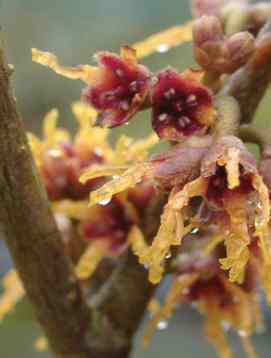Milliways Mail order shop: Advice, tips and tricks.

WITCH HAZEL Hamamelis
Not in stock right now email to go on back order list.This plant will bring you sweetly scented flowers through the gloomy months plant with SARCOCOCCA or Forsythia
Famous for their vibrant autumn colour, Hamamelis (commonly known as witch hazels) have plenty more in store once the leaves have faded and fallen. The bare twiggy and knotted shoots soon become emblazoned with fine petals that often last well into spring. Frost doesn't seem to damage blossom.
Great plant for creating winter texture and useful for flower arrangers. Quite a costly plant for a good specimen as propagation can be tricky, look for a grafted named variety.
Like all winter flowers, what they lack in size is made up for in scent. As almost all witch hazels are deliciously fragrant, you should aim to plant one where you know you are going to walk in winter - either by a path, next to a patio or on the way to the garage. If the thought of going outside doesn't appeal at this time of year, stems will also cut well and last for a few days indoors as long as the room is not too hot.Richly colorful
Making a decision about which tree to plant can be tough. Finding one that is slow growing and doesn't get too big are often the main requirements. Hamamelis x intermedia fits the bill, making a vase-shaped tree no more than 8-10ft. (2.5-3.1m) tall. The hybrid varieties of this plant produce the most richly colorful flowers.
Choose from H. x intermedia "Orange Peel", orange-yellow; H. x intermedia "Diane", crimson-red; H. x intermedia "Jelena" coppery orange and H. x intermedia "Primavera", canary yellow. This is one of the earliest to bloom and often continues all winter. H. x intermedia "Pallida" has a more spreading habit, with an eventual height and spread of 12ft. (3.7m) so give it plenty of room. Its bright yellow flowers are more noticeable than the orange-colored varieties. All are best grown against a dark background so the flowers stand out.
Hamamelis do not necessarily have to grow in acid conditions but they do dislike very thin, chalky soil. Position in sun or light shade in soil that has been improved with well-rotted compost or leaf mould. And remember to mulch trees every year in spring.Prices vary but expect to pay a fair amount for a good one. They are hard to grow and take a lot of nursery space and time. Cheap imports never really work out they just are not hardy enough.
HOME
MORE TO FOLLOW
UNDER CONSTRUCTION BETA SITE LIVE IN MARCH. Email us to be notified of final site.